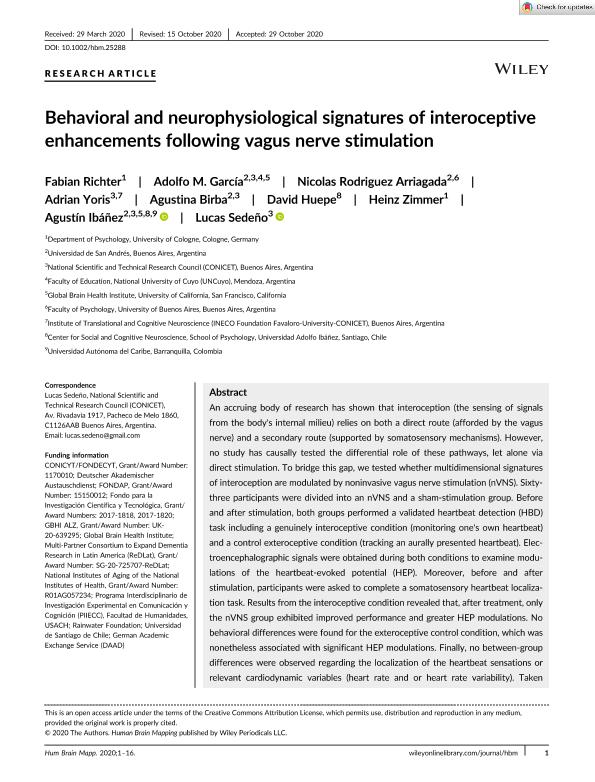Artículo
Behavioral and neurophysiological signatures of interoceptive enhancements following vagus nerve stimulation
Richter, Fabian; García, Adolfo Martín ; Rodríguez Arriagada, Nicolás; Yoris, Adrián Isidro
; Rodríguez Arriagada, Nicolás; Yoris, Adrián Isidro ; Birba, Agustina
; Birba, Agustina ; Huepe, David; Zimmer, Heinz; Ibañez, Agustin Mariano
; Huepe, David; Zimmer, Heinz; Ibañez, Agustin Mariano ; Sedeño, Lucas
; Sedeño, Lucas
 ; Rodríguez Arriagada, Nicolás; Yoris, Adrián Isidro
; Rodríguez Arriagada, Nicolás; Yoris, Adrián Isidro ; Birba, Agustina
; Birba, Agustina ; Huepe, David; Zimmer, Heinz; Ibañez, Agustin Mariano
; Huepe, David; Zimmer, Heinz; Ibañez, Agustin Mariano ; Sedeño, Lucas
; Sedeño, Lucas
Fecha de publicación:
10/2020
Editorial:
Wiley-liss, div John Wiley & Sons Inc.
Revista:
Human Brain Mapping
ISSN:
1065-9471
Idioma:
Inglés
Tipo de recurso:
Artículo publicado
Clasificación temática:
Resumen
An accruing body of research has shown that interoception (the sensing of signals from the body's internal milieu) relies on both a direct route (afforded by the vagus nerve) and a secondary route (supported by somatosensory mechanisms). However, no study has causally tested the differential role of these pathways, let alone via direct stimulation. To bridge this gap, we tested whether multidimensional signatures of interoception are modulated by noninvasive vagus nerve stimulation (nVNS). Sixty-three participants were divided into an nVNS and a sham-stimulation group. Before and after stimulation, both groups performed a validated heartbeat detection (HBD) task including a genuinely interoceptive condition (monitoring one's own heartbeat) and a control exteroceptive condition (tracking an aurally presented heartbeat). Electroencephalographic signals were obtained during both conditions to examine modulations of the heartbeat-evoked potential (HEP). Moreover, before and after stimulation, participants were asked to complete a somatosensory heartbeat localization task. Results from the interoceptive condition revealed that, after treatment, only the nVNS group exhibited improved performance and greater HEP modulations. No behavioral differences were found for the exteroceptive control condition, which was nonetheless associated with significant HEP modulations. Finally, no between-group differences were observed regarding the localization of the heartbeat sensations or relevant cardiodynamic variables (heart rate and or heart rate variability). Taken together, these results constitute unprecedented evidence that the vagus nerve plays a direct role in neurovisceral integration during interoception. This finding can constrain mechanistic models of the domain while informing a promising transdiagnostic agenda for interoceptive impairments across neuropsychiatric conditions.
Archivos asociados
Licencia
Identificadores
Colecciones
Articulos(SEDE CENTRAL)
Articulos de SEDE CENTRAL
Articulos de SEDE CENTRAL
Citación
Richter, Fabian; García, Adolfo Martín; Rodríguez Arriagada, Nicolás; Yoris, Adrián Isidro; Birba, Agustina; et al.; Behavioral and neurophysiological signatures of interoceptive enhancements following vagus nerve stimulation; Wiley-liss, div John Wiley & Sons Inc.; Human Brain Mapping; 42; 5; 10-2020; 1227-1242
Compartir
Altmétricas



